Abstract
OBJECTIVES: (1) To determine the prevalence of sexually transmitted diseases (STDs) in pregnant women in Burkina Faso. (2) To evaluate the potential of clinical management of STDs based on screening with clinical data and urine leucocyte esterase test (LET). METHODS: Cross sectional study among antenatal clinic attendees was conducted in 1994 in Ouagadougou and Bobo-Dioulasso, the two largest urban centres in Burkina Faso, where more than 94% of the pregnant women benefit from antenatal care at least twice during their pregnancy. Each woman selected underwent an interview, general and gynaecological examination. Genital samples were collected to confirm the presence of STD pathogens. Logistic regression analysis was done to identify models that predict (a) gonorrhoea and/or chlamydia, (b) trichomoniasis and/or bacterial vaginosis, (c) candidiasis. Sensitivity, specificity and positive and negative predictive values of these models were assessed using standard methods. RESULTS: All 645 consecutive pregnant women were enrolled in the two sites. Among these women 32.4% presented at least one STD. The major STDs were: trichomoniasis (14%), bacterial vaginosis (13%), recent syphilis (3.6%), chlamydial infection (3.1%), genital warts (3%), gonococcal infection (1.6%) and genital ulcer (0.8%). Prevalence of vaginal candidiasis was 14%. The use of a risk marker (length of relationship with regular sexual partner < 3 years), and the positivity +3 of the urine LET provided a sensitivity of 80% and a positive predictive value of 7% for the screening of gonococcal and/or chlamydial infection. If clinical signs and positivity of the urine LET were taken into account sensitivity and positive predictive value of trichomoniasis and/or bacterial vaginosis screening were 77% and 37%, respectively. Clinical signs and positivity of the urine LET showed a low sensitivity (23%) for screening vaginal candidiasis. CONCLUSIONS: The prevalence of STDs in pregnant women is high in urban Burkina Faso. Systematic screening combined with effective treatment should be included in antenatal care in the future. Urine LET, if associated with interview and clinical examination offers a simple, rapid and affordable tool for systematic screening of STDs in pregnant women. However, the proportion of overtreatments with proposed strategies will be high. Further studies are needed to develop and validate better algorithms with probably cheap laboratory tests.
Full text
PDF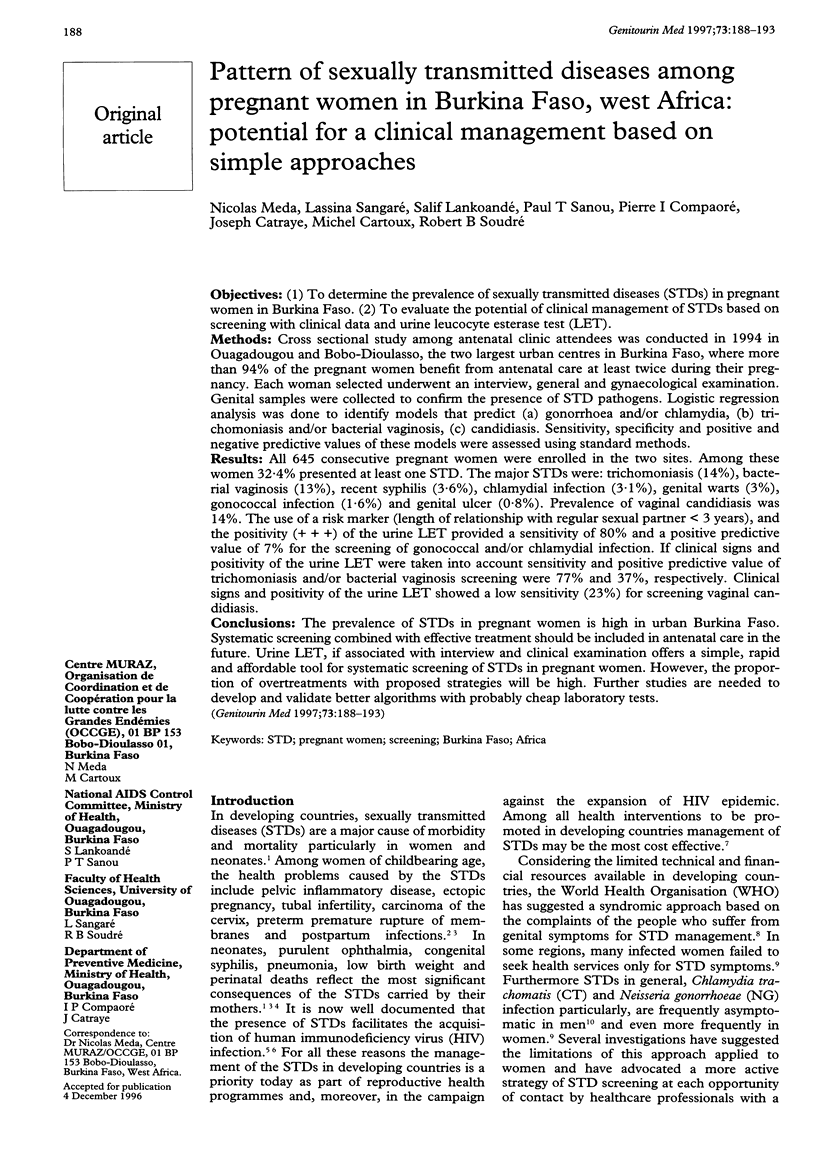
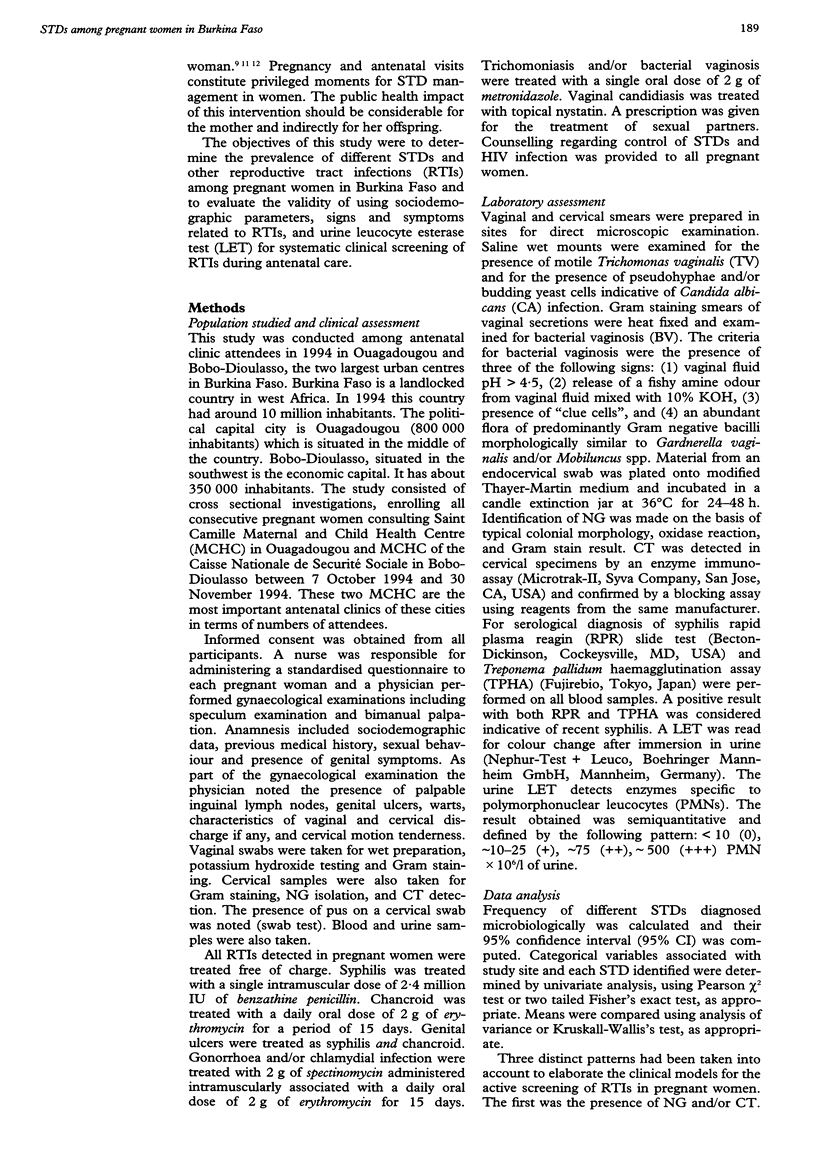
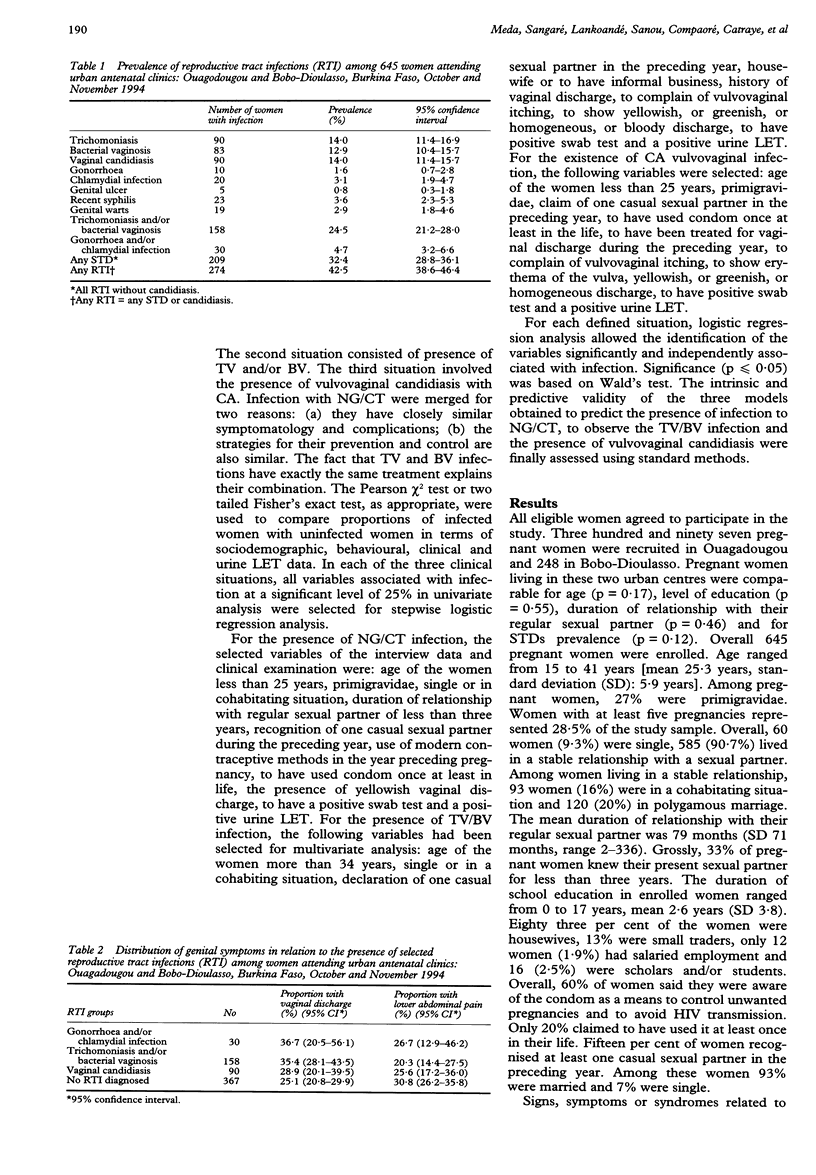
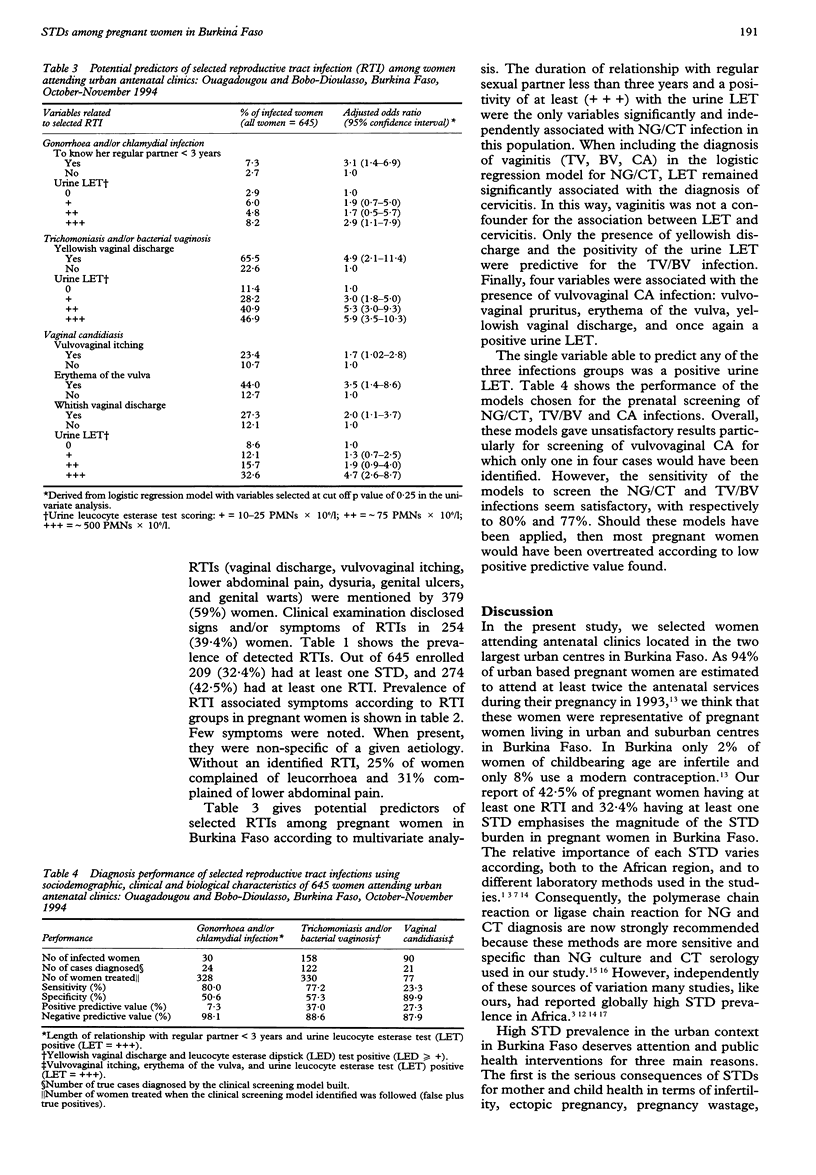
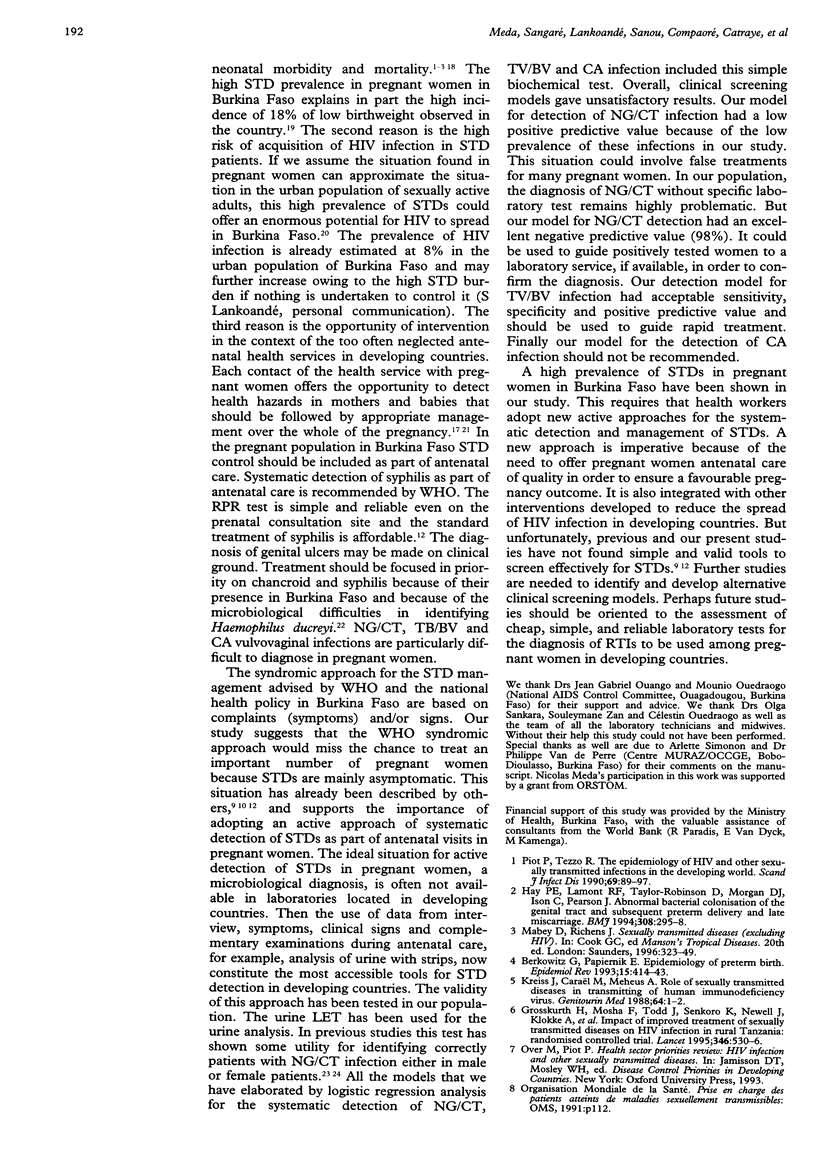
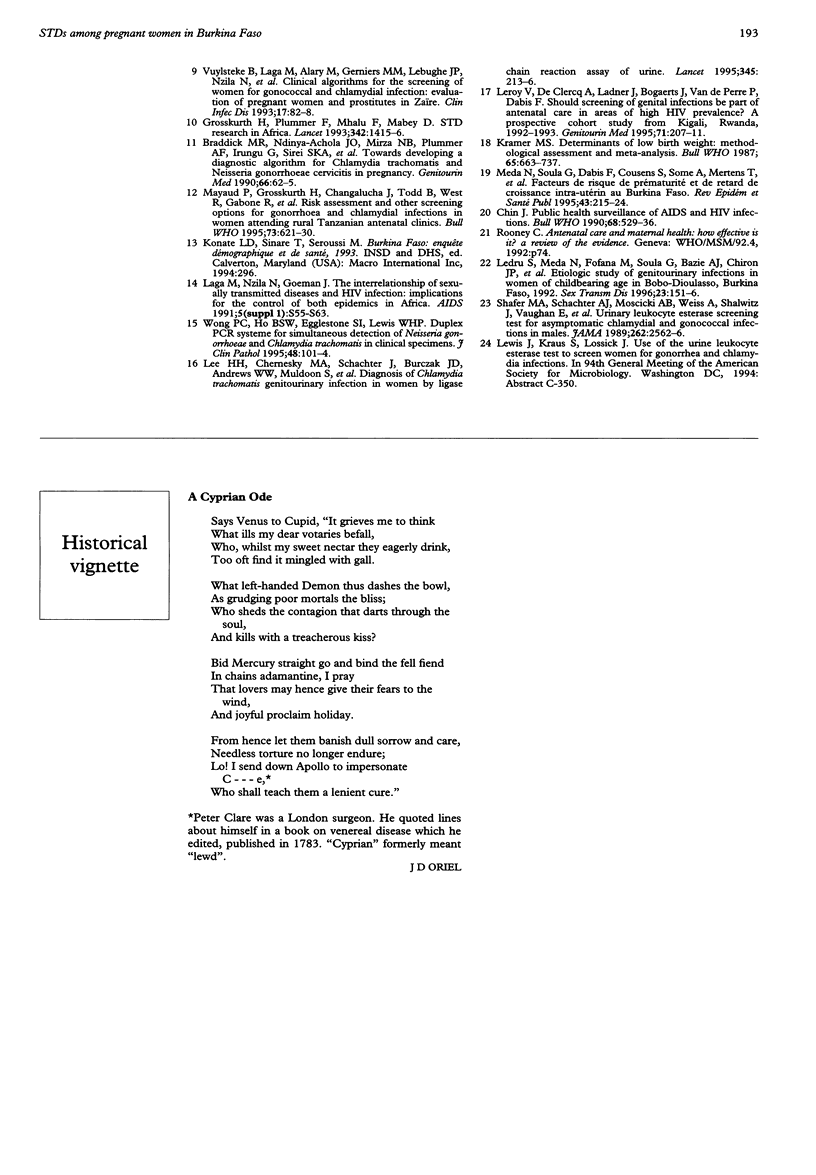
Selected References
These references are in PubMed. This may not be the complete list of references from this article.
- Berkowitz G. S., Papiernik E. Epidemiology of preterm birth. Epidemiol Rev. 1993;15(2):414–443. doi: 10.1093/oxfordjournals.epirev.a036128. [DOI] [PubMed] [Google Scholar]
- Braddick M. R., Ndinya-Achola J. O., Mirza N. B., Plummer F. A., Irungu G., Sinei S. K., Piot P. Towards developing a diagnostic algorithm for Chlamydia trachomatis and Neisseria gonorrhoeae cervicitis in pregnancy. Genitourin Med. 1990 Apr;66(2):62–65. doi: 10.1136/sti.66.2.62. [DOI] [PMC free article] [PubMed] [Google Scholar]
- Chin J. Public health surveillance of AIDS and HIV infections. Bull World Health Organ. 1990;68(5):529–536. [PMC free article] [PubMed] [Google Scholar]
- Grosskurth H., Mosha F., Todd J., Mwijarubi E., Klokke A., Senkoro K., Mayaud P., Changalucha J., Nicoll A., ka-Gina G. Impact of improved treatment of sexually transmitted diseases on HIV infection in rural Tanzania: randomised controlled trial. Lancet. 1995 Aug 26;346(8974):530–536. doi: 10.1016/s0140-6736(95)91380-7. [DOI] [PubMed] [Google Scholar]
- Grosskurth H., Plummer F., Mhalu F., Mabey D. STD research in Africa. Lancet. 1993 Dec 4;342(8884):1415–1416. doi: 10.1016/0140-6736(93)92767-n. [DOI] [PubMed] [Google Scholar]
- Hay P. E., Lamont R. F., Taylor-Robinson D., Morgan D. J., Ison C., Pearson J. Abnormal bacterial colonisation of the genital tract and subsequent preterm delivery and late miscarriage. BMJ. 1994 Jan 29;308(6924):295–298. doi: 10.1136/bmj.308.6924.295. [DOI] [PMC free article] [PubMed] [Google Scholar]
- Kramer M. S. Determinants of low birth weight: methodological assessment and meta-analysis. Bull World Health Organ. 1987;65(5):663–737. [PMC free article] [PubMed] [Google Scholar]
- Laga M., Nzila N., Goeman J. The interrelationship of sexually transmitted diseases and HIV infection: implications for the control of both epidemics in Africa. AIDS. 1991;5 (Suppl 1):S55–S63. [PubMed] [Google Scholar]
- Ledru S., Meda N., Fofana M., Soula G., Bazié A. J., Chiron J. P. Etiologic study of genitourinary infections in women of childbearing age in Bobo-Dioulasso, Burkina Faso, 1992. Sex Transm Dis. 1996 Mar-Apr;23(2):151–156. doi: 10.1097/00007435-199603000-00011. [DOI] [PubMed] [Google Scholar]
- Lee H. H., Chernesky M. A., Schachter J., Burczak J. D., Andrews W. W., Muldoon S., Leckie G., Stamm W. E. Diagnosis of Chlamydia trachomatis genitourinary infection in women by ligase chain reaction assay of urine. Lancet. 1995 Jan 28;345(8944):213–216. doi: 10.1016/s0140-6736(95)90221-x. [DOI] [PubMed] [Google Scholar]
- Leroy V., De Clercq A., Ladner J., Bogaerts J., Van de Perre P., Dabis F. Should screening of genital infections be part of antenatal care in areas of high HIV prevalence? A prospective cohort study from Kigali, Rwanda, 1992-1993. The Pregnancy and HIV (EGE) Group. Genitourin Med. 1995 Aug;71(4):207–211. doi: 10.1136/sti.71.4.207. [DOI] [PMC free article] [PubMed] [Google Scholar]
- Mayaud P., Grosskurth H., Changalucha J., Todd J., West B., Gabone R., Senkoro K., Rusizoka M., Laga M., Hayes R. Risk assessment and other screening options for gonorrhoea and chlamydial infections in women attending rural Tanzanian antenatal clinics. Bull World Health Organ. 1995;73(5):621–630. [PMC free article] [PubMed] [Google Scholar]
- Meda N., Soula G., Dabis F., Cousens S., Some A., Mertens T., Salamon R. Facteurs de risque de prématurité et de retard de croissance intra-utérin au Burkina Faso. Rev Epidemiol Sante Publique. 1995;43(3):215–224. [PubMed] [Google Scholar]
- Piot P., Tezzo R. The epidemiology of HIV and other sexually transmitted infections in the developing world. Scand J Infect Dis Suppl. 1990;69:89–97. [PubMed] [Google Scholar]
- Shafer M. A., Schachter J., Moscicki A. B., Weiss A., Shalwitz J., Vaughan E., Millstein S. G. Urinary leukocyte esterase screening test for asymptomatic chlamydial and gonococcal infections in males. JAMA. 1989 Nov 10;262(18):2562–2566. [PubMed] [Google Scholar]
- Vuylsteke B., Laga M., Alary M., Gerniers M. M., Lebughe J. P., Nzila N., Behets F., Van Dyck E., Piot P. Clinical algorithms for the screening of women for gonococcal and chlamydial infection: evaluation of pregnant women and prostitutes in Zaire. Clin Infect Dis. 1993 Jul;17(1):82–88. doi: 10.1093/clinids/17.1.82. [DOI] [PubMed] [Google Scholar]
- Wong K. C., Ho B. S., Egglestone S. I., Lewis W. H. Duplex PCR system for simultaneous detection of Neisseria gonorrhoeae and Chlamydia trachomatis in clinical specimens. J Clin Pathol. 1995 Feb;48(2):101–104. doi: 10.1136/jcp.48.2.101. [DOI] [PMC free article] [PubMed] [Google Scholar]


